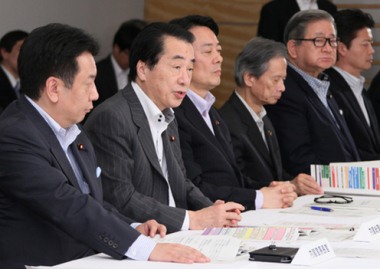The Japanese government has spoken of the future of nuclear power as well as its demands before people evacuated from near the Fukushima Daiichi nuclear power plant can return.
Prime minister Naoto Kan said yesterday that Tokyo Electric Power Company (Tepco) needs to get all the Fukushima Daiichi reactors into 'cold shutdown' before he will judge when the 150,000 evacuees can return.
Kan wants to hit the cold shutdown milestone "no later than mid-January next year" with there being "nearly no release of radioactivity." Given those conditions, and based on monitoring data and decontamination work, the government will advise on whether people can return.
 |
| Naoto Kan pictured during an emergency response meeting on 13 May. He spoke of the government's responsibility for evacuees that are "mentally and physically exhausted" |
Cold shutdown is the goal of the second phase of Tepco's roadmap for stabilisation and is likely to be five to eight months away - on top of the two months that most evacuees have already spent in centres.
The term shutdown means that nuclear processes have halted within the reactor, with cold shutdown meaning that the heat from radioactive decay has been removed effectively enough for coolant water to be below 100ºC. Nuclear reactors normally achieve this state within a few hours of shutting down, but the term is less meaningful for Fukushima Daiichi units 1, 2 and 3 with badly deformed and damaged cores cooled by ad-hoc methods.
Top level talks
In coming days Kan will receive both Chinese premier Wen Jiabao and South Korean President Lee Myung-bak, while on 26 May a G8 summit begins in Deauville, France, at which nuclear power is sure to be a topic of discussion.
In early June a joint G8/G20 meeting organised by the OECD will discuss nuclear energy in Paris. Later that month comes a ministerial conference on nuclear safety under the auspices of the International Atomic Energy Agency in Vienna. |
Kan did not comment on the structural stability of the reactor buildings, which still contain potentially vulnerable nuclear fuel in their cooling ponds. Steel frame outer buildings are planned to be erected around units 1, 3 and 4 to prevent the escape of contamination, with these later surrounded by heavier concrete structures for long-term safety. Tepco is also spraying agents to control dust, clearing up rubble and compacting soil on the site to prevent airborne contamination. Radiation levels on site have dropped to the point that engineers are at work in unit 1, while it is now possible to enter units 2 and 3 to assess conditions.
About 95% of the radioactivity released by the accident has come from iodine-131, from which people were protected by potassium-iodide pills and which decays rapidly. Given its half-life of just eight days, the iodine-131 emitted at the height of the accident sequence on 15 March, for example, has now decayed to just 0.39% of its original radioactivity. The smaller portion comes from caesium-137, which has a half-life of 30 years and may present a greater clean-up issue before residents can return home.
The distribution of these radionuclides on land has been highly uneven with a large amount in a zone about 30 kilometres to the northwest of the power plant, near the village of Iitate. Special measures are in place in these areas, while radiation levels in the majority of the 20 kilometre evacuation zone are close to normal. A separate concern, however, is the condition of the seawater and seabed near the plant, which was subject to prolonged emissions of highly contaminated water.
The future of nuclear
Kan again clarified the decision to renew Japan's energy policy. The country updates this every three years, with the most recent review recommending an expansion of nuclear power from 30% to 53%. This policy has been binned with a new one to be developed "from scratch."
Fossil fuels provide the largest share of Japan's energy and make one pillar of the supply. Nuclear power is another. Kan said that Japan will add two more pillars in the form of energy conservation and renewables. Subsidies will promote solar and wind while Kan aims to establish Japan as a leader in those fields.
Kan thanked Chubu Electric Power Company for shutting down three reactors at the Hamaoka plant for additional flood protection work. All the country's nuclear plants will need to be given specific approval to keep operating in the light of the Fukushima accident. An investigation into the accident and its causes has been promised with a shake-up likely for both industry and government. Kan noted the position of the Nuclear and Industrial Safety Agency within the Ministry of Economy, Trade and Industry does not ensure sufficient independence.
Researched and written
by World Nuclear News




_18570.jpg)
_16159.jpg)
_49205.jpg)
_18938.jpg)





